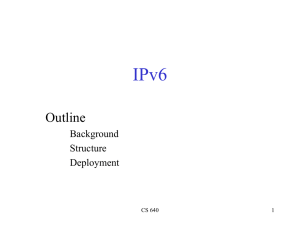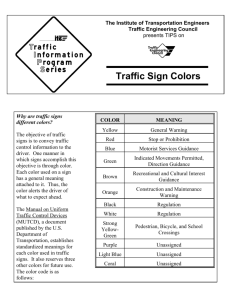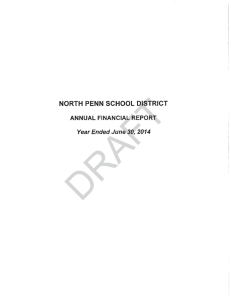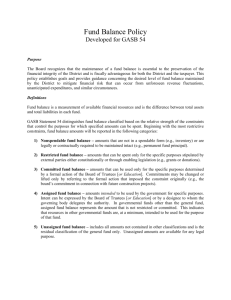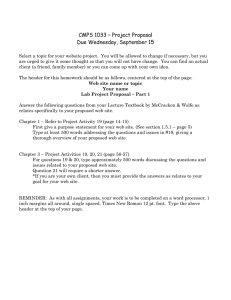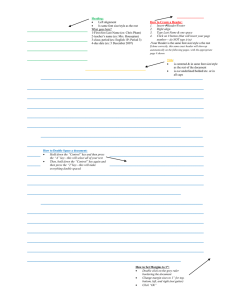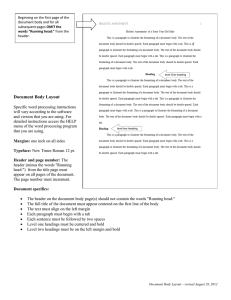ipv6.ppt
advertisement
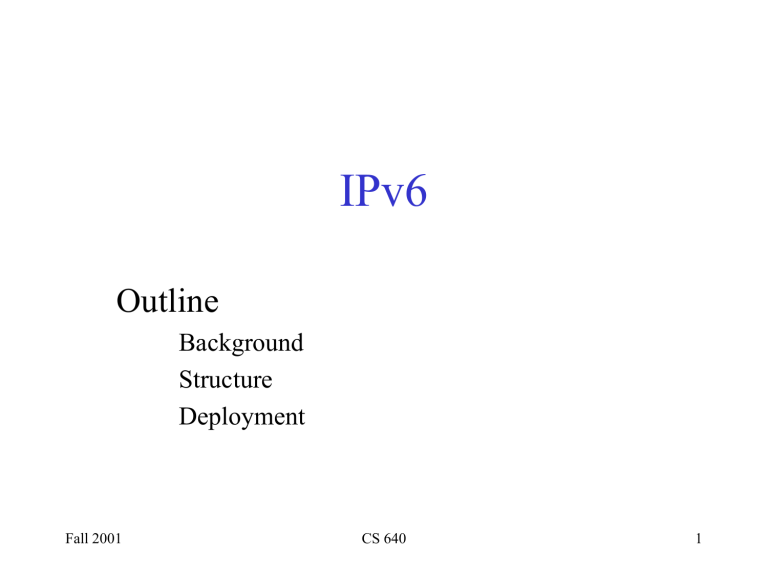
IPv6 Outline Background Structure Deployment Fall 2001 CS 640 1 IPv4 Address Allocation - 1998 Source: www.caida.org Fall 2001 CS 640 2 Holes in v4 Address Space • Each pixel represents a /24 • Routing tables were used to generate yellow portions of the table – routable addresses – Incomplete view of the entire Internet • Packet traces were used to generate black portions of the table – source/destination addresses – Raises more questions than it answers • Class A’s allocated to companies, etc. used for internal routing only (?) • Class B & C allocation from lowest to highest • Reserved address space • Unallocated space Fall 2001 CS 640 3 IPv6 Background • IP has been patched (subnets, supernets) but there is still the fundamental 32 bit address limitation • IETF started effort to specify new version of IP in 1991 – – – – – New version would require change of header Include all modifications in one new protocol Solicitation of suggestions from community Result was IPng which became IPv6 First version completed in ’94 • Same architectural principles as v4 – only bigger Fall 2001 CS 640 4 IPv6 planned support list • 128-bit address space – This is what it’s all about… • Real-time/QoS services • Security and authentication • Autoconfiguration – Hosts autoconfig with IP address and domain name – Idea is to try to make systems more plug-n-play • • • • Enhanced routing functionality eg. Mobile hosts Multicast Protocol extensions Smooth transition path from IPv4 – Can’t do it all at once! Fall 2001 CS 640 5 Address Space and Notation • Allocation is classless – Prefixes specify different uses (unicast, multicast, anycast) • Anycast: send packets to nearest member of a group – Prefixes can be used to map v4 to v6 space and visa-versa – Lots of flexibility with 128 bits! • ~1500 address/sqft of the earths surface • Standard representation is set of eight 16-bit values separated by colons – Eg. 47CD:1234:3200:0000:0000:4325:B792:0428 – If there are large number of zeros, they can be omitted with series of colons • Eg. 47CD:1234:3200::4325:B792:0428 – Address prefixes (slash notation) are the same as v4 • Eg. FEDC:BA98:7600::/40 describes a 40 bit prefix Fall 2001 CS 640 6 Address Prefix Assignments Fall 2001 0000 0000 Reserved 0000 0001 Unassigned 0000 001 Reserved for NSAP (non-IP addresses used by ISO) 0000 010 Reserved for IPX (non-IP addresses used by IPX) 0000 011 Unassigned 0000 1 Unassigned 0001 Unassigned 001 Unicast Address Space 010 Unassigned 011 Unassigned 100 Unassigned 101 Unassigned 110 Unassigned 1110 Unassigned 1111 0 Unassigned 1111 10 Unassigned 1111 110 Unassigned 1111 1110 0 Unassigned 1111 1110 10 Link Local Use addresses 1111 1110 11 Site Local Use addresses 1111 1111 Multicast addresses CS 640 7 Unicast Assignment in v6 • Unicast address assignment is similar to CIDR – – – – Unicast addresses start with 001 Host interfaces belong to subnets Addresses are composed of a subnet prefix and a host identifier Subnet prefix structure provides for aggregation into larger networks • Provider-based plan – Idea is that the Internet is global hierarchy of network – Three levels of hierarchy – region, provider, subscriber – Goal is to provide route aggregation to reduce BGP overhead • A provider can advertise a single prefix for all of its subscribers – Region = 13 bits, Provider = 24 bits, Subscriber = 16 bits, Host = 80 bits • Eg. 001,regionID,providerID,subscriberID,subnetID,intefaceID – What about multi-homed subscribers? • No simple solution • Anycase addresses are treated just like unicast addresses – It’s up to the routing system to determine which server is “closest” Fall 2001 CS 640 8 Recall IPv4 Packet Format Details 0 4 V ersion 8 16 TOS HLen 31 Length Ident TTL 19 Flags Protocol Offset Checksum SourceAddr DestinationAddr Pad (variable) Options (variable) Data Fall 2001 CS 640 9 IPv6 Packet Format 0 4 V ersion 8 16 24 31 Flow Label Traffic Class Payload Lengtht Next Header Hop Limit SourceAddr (4 words) DestinationAddr (4 words) Options (variable number) Data Fall 2001 CS 640 10 Packet Format Details • • • • Simpler format than v4 Version = 6 Traffic class same as v4 ToS Treat all packets with the same Flow Label equally – Support QoS and fair bandwidth allocation • Payload length does not include header –limits packets to 64KB – There is a “jumbogram option” • Hop limit = TTL field • Next header combines options and protocol – If there are no options then NextHeader is the protocol field • Options are “extension header” that follow IP header – Ordered list of tuples – 6 common types • Quickly enable a router to tell if the options are meant for it – Eg. routing, fragmentation, authentication encryption… Fall 2001 CS 640 11 Key differences in header • No checksum – Bit level errors are checked for all over the place • No length variability in header – Fixed format speeds processing • No more fragmentation and reassembly in header – Incorrectly sized packets are dropped and message is sent to sender to reduce packet size – Hosts should do path MTU discovery – But of course we have to be able to segment packets! • What about UDP packets? Fall 2001 CS 640 12 Fragmentation Extension • Similar to v4 fragmentation – Implemented as an extension header • Placed between v6 header and data (if it is the only extension used) – 13 bit offset – Last-fragment mark (M) – Larger fragment ID field than v4 • Fragmentation is done on end host 16 8 0 next header reserved 29 offset 31 reserved M ID Fall 2001 CS 640 13 Routing Extension • Without this header, routing is essentially the same as v4 • With this header essentially same as the source routing option in v4 – Loose or strict • Header length is in 64-bit words • Up to 24 addresses can be included – Packet will go to nearest of these in “anycast” configuration • Segments left tracks current target 8 0 Next header Hd. Ext. Len 16 24 0 31 Segmnts left 1 – 24 addresses Fall 2001 CS 640 14 Transition from v4 to v6 • Flag day is not feasible • Dual stack operation – v6 nodes run in both v4 and v6 modes and use version field to decide which stack to use – Nodes can be assigned a v4 compatible v6 address • Allows a host which supports v6 to talk v6 even if local routers only speak v4 • Signals the need for tunneling • Add 96 0’s (zero-extending) to a 32-bit v4 address – eg. ::10.0.0.1 – Nodes can be assigned a v4 mapped v6 address • Allows a host which supports both v6 and v4 to communicate with a v4 hosts • Add 2 bytes of 1’s to v4 address then zero-extend the rest – eg. ::ffff:10.0.0.1 • Tunneling is used to deal with networks where v4 router(s) sit between two v6 routers – Simply encapsulate v6 packets and all of their information in v4 packets until you hit the next v6 router Fall 2001 CS 640 15 IPv6 Issues • • • • • • Address length: usable addresses vs. overhead Hop limit: is 65K necessary? Max. Pkt. Size: Larger BW calls for larger pkts. Is the checksum necessary? How do servers handle both types of packets? Is security necessary in IP? – How is it best implemented? • DNS can be very important in the transition – how? Fall 2001 CS 640 16
